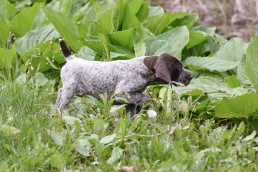Choosing, Caring for Perennial Clovers
SHARE THIS POST
Ah spring—it’s all about regeneration and anew.
You have a clean slate of annual plot locations to work with for the coming year, but how will they benefit your wildlife? If you manage your property for whitetails, turkey or upland birds, a perennial clover blend should be on your food-plot menu. Different varieties are chosen for a wide range of characteristics to meet specific management goals, but a blend of several clover varieties and other perennials like alfalfa, trefoils or chicory, is usually the best choice for most managers.
White clover is a perennial legume that can provide years of quality, high-protein attractive forage for your whitetail herd and other wildlife. Red clovers tend to be a bit easier to grow in a range of conditions. However, they are typically not as attractive as most white varieties.
When planting anything for whitetails, moisture is the key. As long as you receive 30 inches of rainfall annually you should be able to find perennials that will work. In drier or sandy areas, adding deep-rooted perennials like alfalfa and chicory will help in stand survival. In western states like Colorado, Wyoming, Nebraska and the Dakotas, I’ve had success by planting perennials with selected annuals like brassicas. Blends like Premium Perennial or Perfect Plot are my favorites. In Colorado and Nebraska, we’ve had success in areas that receive as little as 12 inches per year. We plant during the late summer to catch the fall rains. The annual brassicas act as a “nurse crop” to conserve moisture and provide forage during the fall. Then, snowmelt brings the perennials back into production during the following spring after winter dormancy for an excellent flush of nutritious forage until a dry hot summer shuts down the growth.
Throughout Canada, the northern tier of states and many of the transitional states, perennials can be planted in spring or late summer. When planted during spring, chances are best for perennial survival, but some experience weed problems. When planted during the late summer, the weed cycle may be easier on you but you must make certain your perennials have about 50 days of frost-free growth to establish a root system or they’ll not be recurrent and come back after dormancy.
When planted in soil initially close to a neutral pH and maintained properly, perennial clover blends can produce for six to eight years, or more. When managed correctly, white clovers will spread by sending out a stem that grows horizontally along the ground surface called a stolon. The stolon will create nodes (a joint on a plant stem where a leaf attaches) where roots will form. This process creates new plants, which will replace the original seedlings after a few years. Persistence is greatest in the varieties that create the most stolons, which tend to be the small-leaved white clovers.
Renewal from seed is also possible. If the plants are not browsed heavily or mowed often they will flower and produce seed. Regeneration from seed helps longevity in areas with dry summer conditions. Large-leaved types (like Non-Typical or Ladino) perform best when they are mowed less frequently or when browsing pressure is limited and plants are allowed to mature. Still, mowing is important with these, especially during the cooler times during the growing season.
The small-leaved types respond better to frequent browsing and/or mowing. Large-leaved varieties grow taller and stand upright more than the small-leaved types, but that does not mean better production.
Are you enjoying this post?
You can be among the first to get the latest info on where to go, what to use and how to use it!
Small-leaved varieties typically have thick stolons and strong roots. Large-leaved types have fewer stolons and usually don’t regenerate or persist as long as medium and small-leaved whites. Thus, large-leaved varieties are also more apt to be un-rooted by browse pressure.
Medium-leaved types (like White Dutch) are, as you’ve probably guessed, intermediate in features; these perform well under a wider range of situations. Given the different management necessities of the numerous varieties, before choosing which type of clover to plant, think about your growing conditions, your deer density in relation to the amount of acreage you have in clover and what you will be able to do for a maintenance routine (how often you will mow, spray with herbicides, fertilize, etc.).
Again, for most people a “blend” of different varieties of both, red and white clover possibly combined with chicory and/or alfalfa will be the best selection. The specific growing/management conditions will bring the favorable cultivars to the forefront. One important consideration to note is that large-leaved clover doesn’t mean more tonnage per acre. The yield of most white clover types (large-leaved through to small-leaved) is comparable if each variety is cared for properly.
I suggest that your total perennial acreage be planted in stages. Remember, if you replant, that means the field will not provide a good source of food for almost an entire hunting season. Ground preparation and planting combined with waiting for germination and the time required to produce enough growth for deer requires so much time that replanting is equivalent to “closing the restaurant” and asking your “guests” to dine somewhere else. By planting in stages you never eliminate all of your perennials at once.
Maintaining perennial clover isn’t as difficult as some think. To begin, for clover to do well it is important to neutralize any soil acidity. Soil pH has a big effect on the availability of nutrients for the plants. In addition, in acidic soil (or low pH) some micronutrients can be present at levels toxic to clover. Legumes are particularly sensitive to acidic soils, so do a soil test and incorporate the necessary lime to neutralize the acidity to bring your pH to 6.5 to 7.0.
How often and how short you mow can also greatly influence production. Frequent mowing during the spring favors white clover growth. Besides how often you mow, another important aspect is how much of the plant’s height is removed during mowing. Some managers do not mow often enough, so when they do they tend to mow too short and at the wrong time. Infrequent mowing during the spring will allow the development of larger leaves. However, this results in less stolon production, fewer daughter plants and the loss of new growth. More frequent mowing, but not removing as much of the plant each time, will restrict total plant height, but enhances stolon survival and increases the stem density per acre. More frequent mowing typically equals a thicker, healthier stand that is more appealing to your herd.
During hot or dry conditions, white clovers should not be mowed frequently and in some cases should even be left un-mowed long enough to produce seed heads. With a perennial white clover blend, a good stand can be encouraged both, by frequent mowing during the spring to increase stolon production and survival, and no mowing to promote seed production during droughts or when the clover is growing slowly.
The use of herbicides is also recommended. I typically treat areas with a grass-specific herbicide once or twice during the growing season. Clethodim and sethoxydim are the two most popular active ingredients in grass herbicides. I favor the clethodim brands. Mowing should keep broadleaf weeds out of your plots and a grass herbicide should help rid any remaining competition.
MWO
SHARE THIS POST
Did you enjoy this post?
You can be among the first to get the latest info on where to go, what to use and how to use it!
Todd Amenrud
Todd Amenrud is a full time sportsman whose passion is bowhunting whitetails. He spends considerable time researching whitetails, and has written six books on the subject. Harvesting 47 record-book animals and his ability to share his knowledge have made him one of the Midwest’s most-recognized hunting resources.



